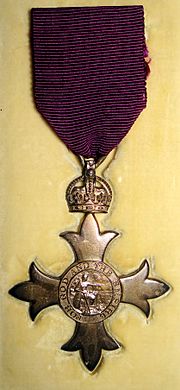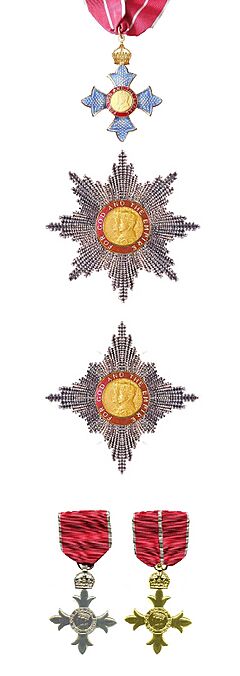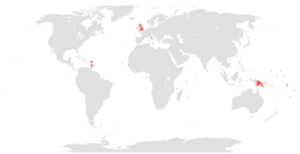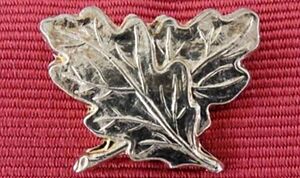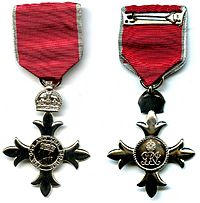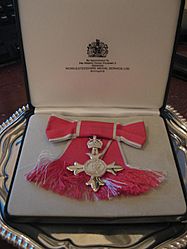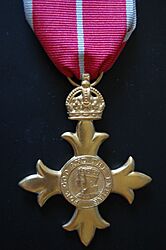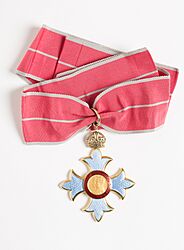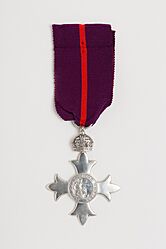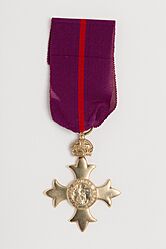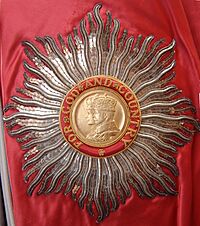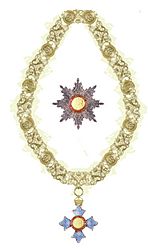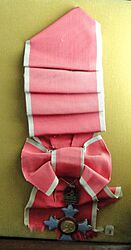Order of the British Empire facts for kids
Quick facts for kids Most ExcellentOrder of the British Empire |
|
|---|---|
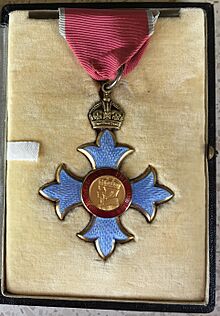
CBE neck decoration (in civil division)
|
|
| Awarded by the Monarch of the Commonwealth Realms |
|
| Type | Order of chivalry |
| Established | 1917 |
| Motto | For God and the Empire |
| Eligibility | British nationals, citizens of the Commonwealth realms, or anyone who has made a significant achievement for the United Kingdom |
| Awarded for | Prominent national or regional achievements |
| Status | Currently constituted |
| Sovereign | Charles III |
| Grand Master | Queen Camilla |
| Grades |
|
| Former grades | Medal of the Order for Gallantry |
| Precedence | |
| Next (higher) | Royal Victorian Order |
| Next (lower) | Varies, depending on rank |
Military ribbon Civil ribbon |
|
The Most Excellent Order of the British Empire is a special award system in Britain. It celebrates people who have done amazing things for their country. This award is given for many different kinds of helpful work, both in civilian life and in the military.
The Order has five main levels of awards. The top two levels allow the person to be called a knight (for men) or a dame (for women). There is also a related award called the British Empire Medal, which is connected to the Order but does not make someone a full member.
King George V started this Order on June 4, 1917. He wanted to recognize people, both men and women, who had done important services for the British Empire. This included services in the UK and in other countries. Today, most people who receive these awards are citizens of the UK. However, some Commonwealth realms (countries that have the British monarch as their head of state) still give out these awards. People from other countries can also receive honorary awards if they have done something important for the UK.
Contents
Levels of Awards
The Order of the British Empire has five different levels, from the highest to the lowest:
- Knight Grand Cross or Dame Grand Cross (GBE)
- Knight Commander or Dame Commander (KBE or DBE)
- Commander (CBE)
- Officer (OBE)
- Member (MBE)
If you receive one of the top two awards (Knight or Dame Grand Cross, or Knight or Dame Commander), you can use the title "Sir" before your first name if you are a man, or "Dame" if you are a woman. This is true unless it is an honorary award.
History of the Order
King George V created this Order to fill a gap in the British awards system. Before this, other awards mostly honored royals, important leaders, or senior military officers.
The King wanted to honor the many thousands of people across the British Empire who helped during the First World War. These were people who worked in non-fighting roles.
From the start, the Order had five levels and was open to both women and men. It also allowed for honorary awards for people from other countries. At the same time, the Medal of the Order of the British Empire was created. This was a lower award that connected people to the Order, but they were not full members. The very first awards were given out in 1917 at Ibrox Stadium in Glasgow.
The Order was first meant for civilian achievements. However, in August 1918, a "Military Division" was added. This meant that military personnel could also receive these awards. Military awards had a red stripe down the middle of the ribbon, while civilian awards had a plain purple ribbon.
Over time, the rules for the Order changed. In 1922, the number of awards given each year was limited. Also, the Medal of the Order was split into awards "for gallantry" (bravery) and "for meritorious service" (good service). The medal for gallantry later became the Empire Gallantry Medal. In 1940, people who had received the Empire Gallantry Medal were asked to exchange it for a new, very important bravery award called the George Cross. The medal for "meritorious service" was renamed the British Empire Medal (BEM) in 1941.
In 1937, the look of the awards changed. The image of Britannia on the badge was replaced with the crowned heads of King George V and Queen Mary. The ribbon color also changed from purple to "rose pink with pearl grey edges." Military awards still had a pearl grey stripe in the middle.
During the Second World War, many more military awards were given out. Between 1939 and 1946, over 33,000 military awards were made. Over time, countries in the Commonwealth started to create their own award systems. For example, Canada stopped recommending people for the Order of the British Empire in 1966. Australia stopped in 1989, and New Zealand in 1996. However, some Commonwealth countries still use the Order today.
In 1993, Prime Minister John Major made some changes to the awards system. The goal was to recognize more people for great service, especially for volunteer work. The British Empire Medal (BEM) stopped being awarded by the UK at this time, and people who would have received it became eligible for the MBE. However, the BEM started being awarded again in 2012 for Queen Elizabeth II's Diamond Jubilee.
In 2004, some people suggested changing the name of the Order to "Order of British Excellence" because the word "Empire" was seen as old-fashioned. They also suggested other changes, but the government decided not to make these changes.
Today, there are rules to make sure awards are given fairly across different areas like:
- Arts and media
- Community and volunteer work
- Economy
- Education
- Health
- Politics
- Science and technology
- Sport
- State (government work)
Most awards are given for community and volunteer service.
How the Order is Organized
The Order has a limited number of members for the highest levels. For example, there can only be 300 Knights and Dames Grand Cross. However, there are no limits on the total number of Officers and Members, though there are limits on how many can be appointed each year. Even though it has many members, it gives out fewer knighthoods than some other British Orders.
Sometimes, people who have already received an award in the Order might be given a higher award later on.
The Sovereign and Grand Master
The British monarch is the head of the Order. They choose all the other important people in the Order. The second most important person is the Grand Master. This role is usually held by a member of the Royal Family.
Here are the people who have been Grand Master:
| No. | Portrait | Name (Born–died) |
Term of office | |
|---|---|---|---|---|
| Took office | Left office | |||
| 1 | Edward, Prince of Wales (1894–1972) |
4 June 1917 | 20 January 1936 | |
| 2 | Queen Mary (1867–1953) |
27 March 1936 | 24 March 1953 | |
| 3 |  |
Prince Philip, Duke of Edinburgh (1921–2021) |
1 June 1953 | 9 April 2021 |
| 4 |  |
Queen Camilla (1947–present) |
23 April 2024 | present |
Other Important Roles
Besides the Sovereign and Grand Master, the Order has six other officers:
- Prelate: The Bishop of London
- Dean: The Dean of St Paul's
- Secretary: Secretary of the Central Chancery of the Orders of Knighthood
- Registrar: Secretary of the Cabinet and Head of the Civil Service
- King of Arms
- Lady Usher of the Purple Rod
These roles help manage the Order and its ceremonies.
Awards in Commonwealth Countries
Many Commonwealth realms have created their own national award systems. However, some still recommend people for the Order of the British Empire. As of 2024, these countries include:
- Antigua and Barbuda
- The Bahamas
- Belize
- Cook Islands
- Grenada
- Papua New Guinea
- Saint Christopher and Nevis
- Saint Lucia
- Solomon Islands
Honorary Awards
Most members of the Order are citizens of the UK or other Commonwealth countries that use the UK's award system. However, people from other nations (where the British monarch is not the head of state) can receive honorary awards. They can use the letters after their name (like GBE, KBE), but they cannot use the title "Sir" or "Dame." If an honorary member later becomes a citizen of a Commonwealth country, their award can become a full membership, and they can then use the "Sir" or "Dame" title if their award level allows it.
Awards for Bravery
Even though the Order was first for good service, it also started to be given for bravery. During the Second World War, many military personnel and civilians received these awards for brave actions that were not quite at the level of the George Medal.
From 1958 to 1974, if someone received an award in the Order for bravery, they wore a special emblem of two crossed silver oak leaves on their ribbon. This award could not be given after someone had passed away. In 1974, the Queen's Gallantry Medal (QGM) replaced it.
The Insignia (What the Awards Look Like)
- Badges and ribands of the Order of the British Empire (1937–present)
When the Order began in 1917, people received badges, ribbons, and stars. In 1929, special cloaks (mantles), hats, and collars were added for the highest level of the Order (GBE). The designs of all these items changed significantly in 1937.
The Badge
Everyone in the Order wears a badge. Its size, color, and design depend on the award level. The badge is a cross shape with a round medal in the middle. Since 1937, the medal shows King George V and Queen Mary with the Order's motto, "For God and the Empire." Before 1937, it showed Britannia. The badges for the higher levels are larger and colorful, while those for Officers and Members are plain silver or silver-gilt.
The Ribbon
From 1917 to 1937, the ribbon was purple. A red stripe was added for military awards in 1918. Since 1937, the ribbon has been rose-pink with pearl-grey edges. Military awards have an extra pearl-grey stripe in the middle.
Knights and Dames Grand Cross wear a wide ribbon (sash) across their body. Men at the Knight Commander and Commander levels wear the badge from a ribbon around their neck. Male Officers and Members wear it from a ribbon on their left chest. Women (except Dames Grand Cross) usually wear it from a bow on their left shoulder.
The Star
An eight-pointed star is worn on the left chest by Knights and Dames Grand Cross. Knights and Dames Commander wear a smaller star. The star is not worn by the lower levels. Like the badge, the star's center changed in 1937 from Britannia to King George V and Queen Mary.
- Badges and ribands of the Order of the British Empire (1917–1937)
Mantles and Collars
In 1929, special cloaks (mantles), hats, and collars were added for the highest level (GBE).
- The mantle is a rose-pink cloak lined with pearl-grey silk. It has a star of the Order on the left side.
- A black hat with plumes was also part of the uniform, but it is rarely worn now.
- The collar is made of gold. It has medallions showing the Royal Arms and King George V's royal symbol.
Only Knights and Dames Grand Cross wear these special items. The mantle is usually worn only for very important events like coronations. The collar is always worn with the mantle. On certain "collar days," members can wear the collar over their formal clothes.
Collars must be returned when the owner passes away, but other awards can be kept.
- Knight and Dame Grand Cross insignia
The British Empire Medal is made of silver. It shows Britannia and the motto, with "For Meritorious Service" on the front. The back has King George V's symbol and "Instituted by King George V." The recipient's name is engraved on the edge.
A small lapel pin was introduced in 2006 for everyday wear. It is available to all levels of the Order and BEM holders. The pin shows the Order's badge inside a circle of its pink and grey ribbon.
| Civil | Military | |
|---|---|---|
| 1917–1935 | ||
| Since 1936 |
The Chapel
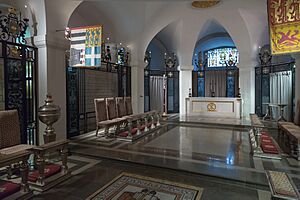
The Chapel of the Order of the British Empire is located in the crypt (underground area) of St Paul's Cathedral in London. It was officially opened in 1960. The chapel usually displays the banners of the Order's Sovereign and Grand Master. The Order now holds its main services in the larger nave (main part) of the cathedral. These services happen every four years, and new Knights and Dames Grand Cross are formally welcomed there.
Titles and Privileges
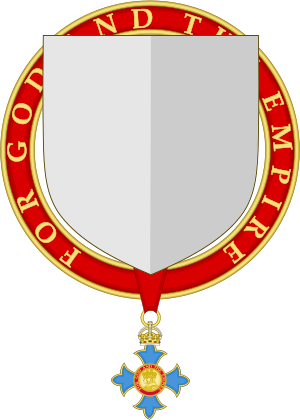
If you are a Knight Grand Cross or Knight Commander, you use "Sir" before your first name. If you are a Dame Grand Cross or Dame Commander, you use "Dame." For example, Sir Paul McCartney or Dame Judi Dench. The wives of Knights can use "Lady" before their husband's last name.
Members of all levels of the Order are given a special place in the order of precedence. This is a formal list that shows who ranks higher than whom at official events.
Knights and Dames Grand Cross can also have special designs added to their coat of arms. They can show the Order's motto circle and collar around their arms. Knights and Dames Commander and Commanders can show the motto circle, but not the collar.
Giving Up an Honour
Only the monarch can officially take away an honour. This happens if someone has done something very wrong, like committing a serious crime. However, a person can choose to return their award as a symbol of protest. Even if they return it, the honour is still officially theirs unless the monarch formally cancels it.
For example, John Lennon returned his MBE award in 1969 as a protest. But the honour was never officially taken away by the Queen, so he still officially held it.
People Who Have Declined Honours
Some people have chosen not to accept an award from the Order of the British Empire. In 2003, a newspaper published a list of people who had turned down the award, including famous figures like David Bowie and John Cleese.
The Order has faced some criticism because its name includes "British Empire," which reminds some people of a time when Britain ruled many countries. For example, the poet Benjamin Zephaniah refused his Officer award in 2003. He said it reminded him of "thousands of years of brutality."
The author C. S. Lewis (who wrote the Narnia books) was offered an honour in 1951 but declined it. He wanted to avoid being linked to any political issues. In 2019, comedian John Oliver also turned down an OBE.
The Beatles were made Members of the Order in 1965. John Lennon once said that they deserved their awards for entertaining people, comparing it to military awards given for fighting.
Another criticism is that many people receive these awards just for doing their regular jobs, especially those in government service.
Images for kids
See also
 In Spanish: Orden del Imperio Británico para niños
In Spanish: Orden del Imperio Británico para niños


